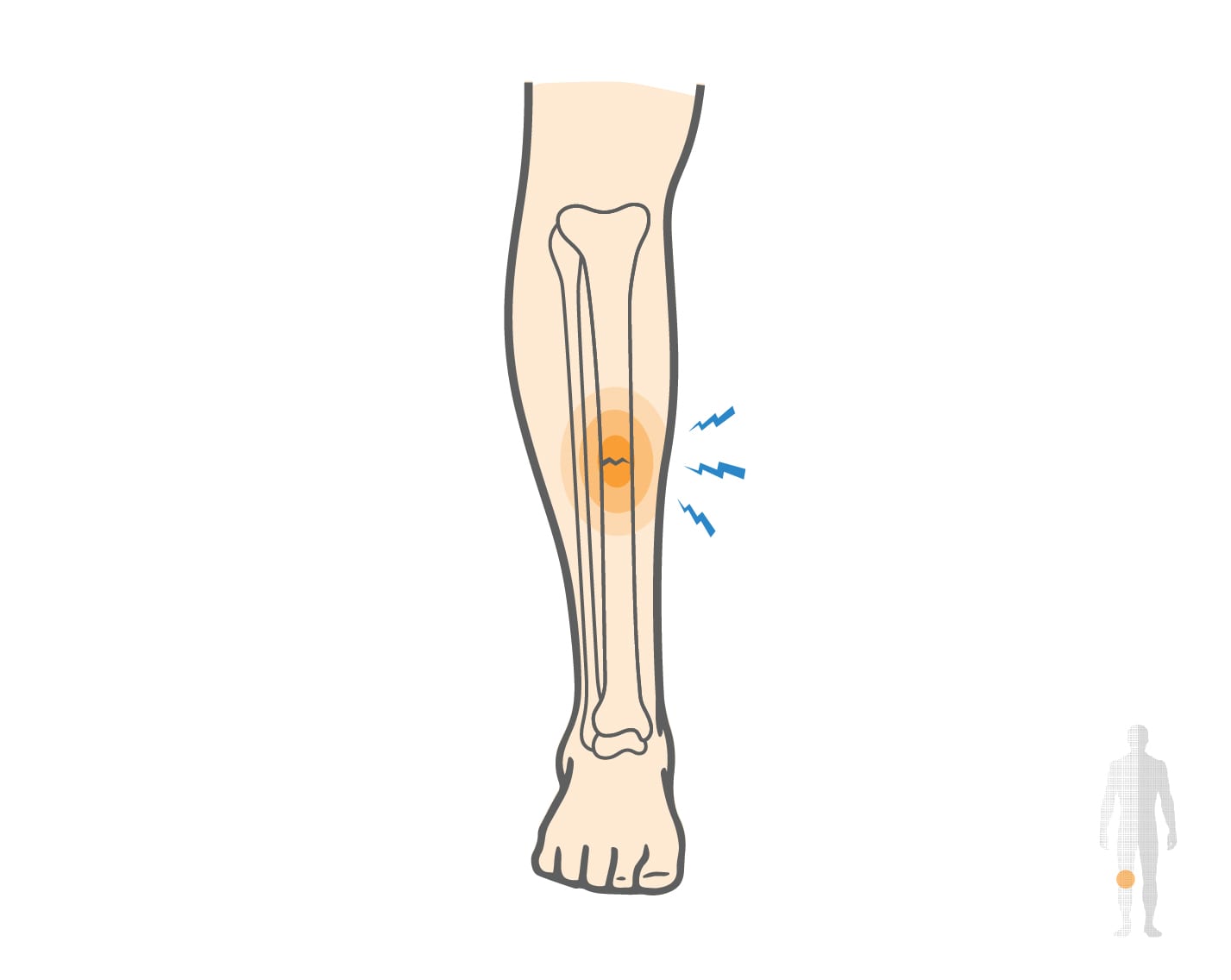The Unexpected Guest: What Is a Tibia Stress Fracture?


A stress fracture isn’t a dramatic crack that snaps your day in two. That’s a full fracture—fast and obvious. This is different. It’s slow. Silent. A tiny crack in your shin bone that grows under pressure.
Think of your tibia as the supporting column of a building. Every step you take adds weight. Every jump, more stress. At first, your bone adapts. But if you’re pushing it too hard, too fast, or with the wrong form…the structure starts to crack. And before you know it, that crack becomes a problem.
What Exactly Is a Tibia Stress Fracture?
Let’s clarify that a stress fracture of the tibia doesn’t resemble that clean, dramatic snap we witness in an X-ray after some sporting injury. It is more of a silent killer. Consider it like a crack forming on a sidewalk—slow, invisible to the eyes initially, and then suddenly all in front of you.
Tibia, or shinbone, is the larger of the two bones of the lower leg. It carries most of one’s weight while walking, running, or jumping. Therefore, much pressure is applied, especially if you run great distances.
Stress fractures develop when the bone cannot grow again fast enough to counteract the microinjury occurring on its surface. Tiny cracks start appearing. If ignored, they deepen. If neglected for long, they might lead to complete breaks.
Sounds scary? It can be. However, with proper care, it is manageable.
How You Got Here: Unpacking the Causes
Let’s break it down. Why would your bone decide to crack?
1. You Ramped Up Too Fast
Say you suddenly go from couch to 5K. Or you tack on sprint workouts with zero buildup. Bones don’t adapt overnight. They need gradual stress and solid recovery. Without that balance, micro-damage adds up.
2. Your Shoes or Surface Aren’t Helping
Ever run in worn-out sneakers? Or on concrete slabs? That impact travels straight up your legs. No cushioning means your shin takes the full brunt, day after day. Ouch.
3. Your Body’s Alignment Isn’t in Sync
Ever noticed one knee nudges inward? Or does your foot flatten out? These quirks shift how force travels through your leg. That extra twist and slight misalignment might not bother you now, but your tibia feels every adjustment.
4. You’re Low on Nutrients or Bone Density
Vitamin D, calcium, estrogen—they matter. If your bones are undernourished, under-hormonal, or just not dense enough, they’re like rubber that’s been overstretched: weak and ready to strain.
5. Life Switched Up Suddenly
New city? New job? Different surface? Even that kind of change can shift stress onto unsuspecting parts of your body. Bones don’t like surprises—they like consistency. So when routine shifts, micro-injuries can follow.
The Soft Whisper Before the Shout: Early Symptoms
This is where it gets sneaky. You won’t hear a loud crack. You’ll feel a whisper of discomfort.
- Gentle pain along your shin during or after activity
- Pressure, dullness, maybe a throbbing ache
- Swelling—not dramatic, but enough to feel “off”
- Tenderness, like there’s a bruise under the skin
Here’s the catch: it feels like soreness…until it doesn’t. Muscle soreness eases with movement. A stress fracture? It gets louder as you move.
When You Ignore It: The Real Risks
Skip this early stage, and you’ll be flirting with disaster.
Think complete fracture—sudden pain, likely immobilization, maybe even surgery. That’s weeks or months off your feet. Suddenly, the tiny whisper became a shout—and you didn’t listen.
The Detective Work: How It’s Diagnosed
You walk into a place. They ask about your habits. They press on your shin. They look at swelling. They suggest imaging.
X-rays? They might not really show anything early on. An MRI or bone scan might be next. Those studies catch stress injuries before they blow into something catastrophic. Getting the injury early and a correct tibial stress fracture treatment is more than an ‘I’m injured’ claim; it is about setting up for a comeback.
The Healing Journey: What Happens Next
Step 1: Rest (But Not Idle)
At first, weight-bearing might be off-limits. Or limited. You’ll swap impact exercises for safe ones: swimming, upper-body circuits, cycling. You stay moving, but strategically.
Step 2: Strengthen Smartly
Time to build what needs support: shin muscles, glutes, and core. We’ll rewire patterns that put stress on your bones. Watch video-based workouts that guide you step-by-step; they’re like a coach in your living room.
Step 3: The Bridge Back
Here’s the kicker: don’t rush. Use pain as your guide. Run pain-free? Good. Add a few more strides. Felt something? Back off a notch. It’s little wins that rebuild your confidence and strength.
Step 4: Build a Safety Net
Once you’re moving freely again, this is the moment you recalibrate your long game:
- Choose footwear that fits like a hug, but with enough bounce
- Rotate movements—don’t just run
- Log your mileage and rest days
- Streamline nutrition: fuel your bones, hydrate, and sleep enough
It’s not a rigid formula—it’s smart living.
Relearning Trust in Your Body
Buying into all these negative thoughts is probably one of the biggest hurdles in the psychological recovery from the stress fracture of the tibia. That little voice crawling into your ear as you apply your shoes says: Has the injury healed? Will it return? Can I do this without getting hurt again?
Normal, really.
Your body’s way of saying “something’s not right” can tremendously impact your confidence. That questioning, suspicious thought process begins to fertilize into suspicion. Every little bit of pain stands out suspiciously. What follows? Walking turns into an option; every step becomes a possibility. And that’s the hardest part of all, trusting yourself again.
The best news about all this is that your body wants to heal. It’s designed to recover. Given appropriate instructions and gradual progress with ample support, the brain follows along. One pain-free walk turns into ten minutes of jogging and then steady running. Confidence doesn’t come back overnight. It builds up over time, like your bone did: one layer at a time.
There is no race to be run; certainly, you never have to prove anything to anyone. There is only a gentle return to doing what feels right. What feels strong? What feels like you?
Let the injury be your guide. Let your recovery reflect that your body still sides with you, and that you have what it takes to return healed and empowered.
Feeling the Pressure? You’re Not Alone
The moment you feel pain, and it sidetracks you even for a minute, guilt may emerge into the scenario. There may be lots of frustration and self-questioning: “Am I letting myself down?” Remember this: You are not failing. You are responding. Your body communicates, “Hey, let’s slow down before things really break.”
Stopping does not mean quitting. It is the act of responding. It is insight. You are being given the chance to gain more strength, not just in your bones but also in your mindset.
Wrapping It Up
That dull ache down your shin is not just annoying; it is a warning. And yes, yes, it does entirely suck to press the rehab button for stress fracture shin treatment. Yet, with Upswing Health, this step leads to healing, to learning, to better movement.
Listen to the whisper. Let it show you the way. Sometimes, what’s a step backward becomes a giant leap onto something awesomer. Something smarter.
You don’t have to do this alone. You don’t have to wait till the pain gets out loud and obnoxiously demanding. With this, you choose to heal and come back stronger, more aware, and in tune with your body than ever.



